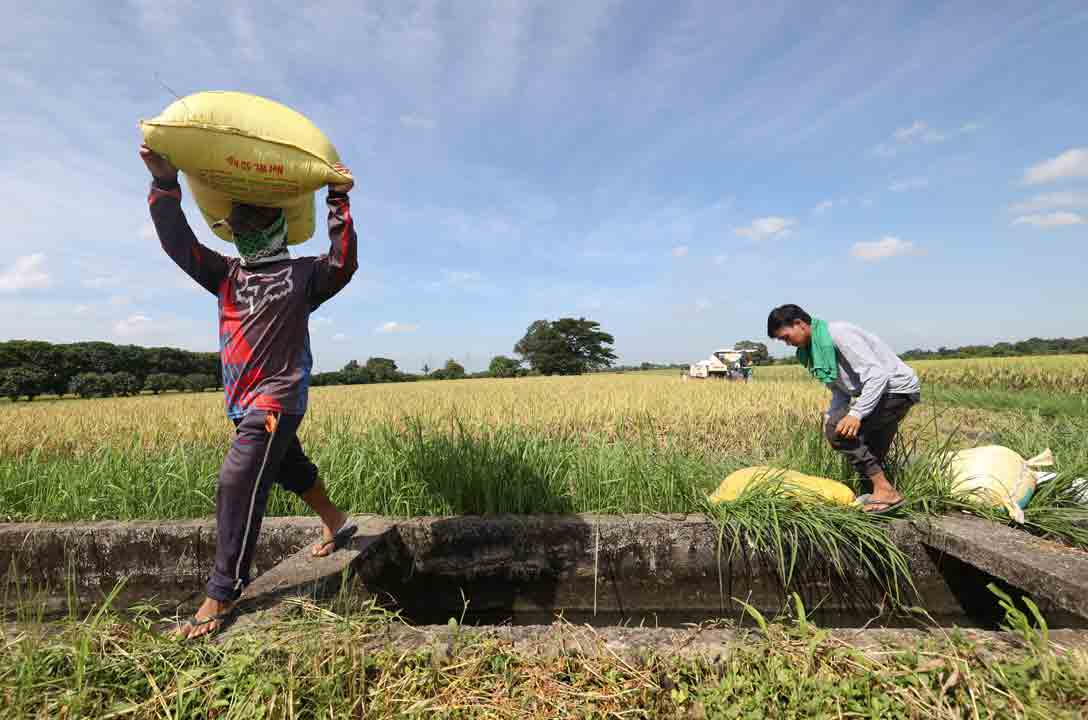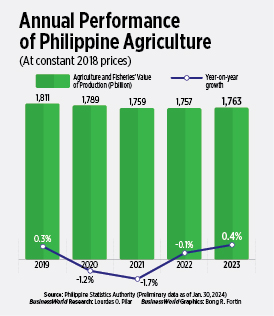Agricultural output up 0.4% in 2023

By Adrian H. Halili, Reporter
THE Philippines’ agricultural output posted modest growth in 2023 as crops, livestock, and poultry production improved, the Philippine Statistics Authority (PSA) said.
Data from the PSA showed the full-year value of production in agriculture and fisheries at constant 2018 prices expanded by 0.4%, well-below the Department of Agriculture’s 2.3%-2.5% growth target.
This was a reversal of the 0.1% contraction in farm output last year. It was also the first time agricultural output posted growth after three straight years of decline or since the 0.3% growth in 2019.
The PSA attributed the increase to higher production in crops, livestock, and poultry, although this was tempered by the decline in fisheries.
In the fourth quarter, the value of agricultural production rose by 0.7%, a reversal of its 1% drop in the same period in 2022 and the 0.2% decline in the third quarter of 2023.
At current prices, the value of production in agriculture and fisheries rose by 7.8% year on year to P659.02 billion in the fourth quarter.
The agriculture sector contributes around a tenth to overall gross domestic product (GDP). Fourth-quarter and full-year 2023 economic data are scheduled to be released today (Jan. 31).
Elias Jose M. Inciong, president of the United Broiler Raisers Association, said agriculture production may have expanded last year as it was coming from a low base in 2022.
“It is premature to talk about a rebound or even growth,” he said in a Viber message.

Crop output, which accounted for more than half of total agricultural production, inched up 0.1% in the October-to-December period, a reversal of the 1% decline during the same period in 2022.
For the full year, crop production rose by 0.7%, reversing the 1% contraction in 2022.
“For crops, weather was more favorable with less typhoons. Given that, however, output should have been much higher,” Federation of Free Farmers National Manager Raul Q. Montemayor said in a Viber message.
PSA data showed that palay or unmilled rice production went up by 0.2% in the fourth quarter, a turnaround from the 2.5% drop in the same period in 2022. For 2023, palay production jumped by 1.5%, an improvement from the 1% decline in 2022.
Palay production reached 20.06 million metric tons (MT) in 2023, translating to about 13.2 million MT of rice.
Roy S. Kempis, retired Pampanga State Agricultural University professor, said favorable weather conditions helped boost crop production last year.
“The near absence of typhoons that would land on Philippine soil is favorable to crop production, thus, crop output in (the fourth quarter) could prop up overall growth. The use of weather-resilient farming innovations also helped the crop sector grow,” Mr. Kempis said in a Viber message.
Philippine Institute for Development Studies Senior Research Fellow Roehlano M. Briones said in a Viber message the slight rebound in crops was partly due to higher farmgate prices, especially for rice.
The national farmgate price for palay rose 14% to an average of P19.89 per kilo in 2023, the PSA reported.
In the fourth quarter, corn output declined by 1.8%, slightly better than the 6.9% drop in the same period in 2022. However, corn production grew by 1.8% in 2023, a turnaround from the 0.3% dip in 2022.
Other crops also saw double-digit growth in the October-to-December period such as cabbage (15.5%) and sugarcane (10.5%), while increases were seen in mango (7.6%), ampalaya (4%), cacao (3.4%), eggplant (3%), abaca (2.9%), tomato (2.6%), and tobacco (2.1%).
On the other hand, lower production was seen in rubber (-7.5%), onion (-6.8%), potato (-5.3%), sweet potato (-4.7%), calamansi (-4.3%), cassava (-2.7%), coconut (-1.9%), coffee (-1.7%), and banana (-0.2).
“Good prices for agricultural commodities on the part of the farmer-producers (are) the best incentive to production. If we can calibrate the role and margins of traders, we can predict more productivity from the producers,” Danilo V. Fausto, presi-dent of the Philippine Chamber of Agriculture and Food, Inc. said in a Viber message.
LIVESTOCK, POULTRY
Meanwhile, PSA data showed livestock production increased by 2.7% in the fourth quarter, slightly higher than the 2.5% growth a year ago.
For 2023, livestock output jumped by 2.5%, an improvement from the 1.9% print in 2022.
In the fourth quarter, dairy production surged by 17.2%, faster than the 1% growth in the same period in 2022.
Output growth was seen for hogs (3.7%) and goat (1.3%), while lower production was reported for cattle (-2.6%) and carabao (-0.9%).
PSA data also showed poultry output grew by 7.8% during the fourth quarter, faster than the 1.8% print a year ago. For the full year, poultry production rose by 3.8%, slower than the 7% growth in 2022.
Mr. Inciong said the growth in the poultry sector could be attributed to more “big players” going into the broiler industry.
“Aside from local players, such as SMC (San Miguel Corp.), Bounty, Vitarich, and Foster, foreign companies were also aggressive in the loading of broiler breeders,” he said.
All sub-sectors under poultry showed growth in the fourth quarter, such as chicken (8.1%), chicken egg (7.8%), duck (0.6%), and duck eggs (0.3%).
“For livestock and poultry, production outputs were the stable and consistent backbone of the overall agricultural output in 2023,” Mr. Kempis said.
“These two sectors tend to be insulated from climate and weather condition changes, especially with the continuing transformation of housing technologies that allowed for climate-controlled environment in maintaining temperatures appropriate for growing both swine and broiler,” he added.
FISHERIES SLUMP
Fisheries production slumped by 5.2% in the fourth quarter, slightly better than the 6.7% decline a year ago.
For the full year, fisheries output dropped by 6.5%, worsening from the 5% slide in 2022.
Mr. Kempis said that the effects of the southwest monsoon and north-easterlies may have prevented fisherfolk from venturing to sea, leading to a further decline in production.
For the October-to-December period, double-digit declines were seen in the production of fimbriated sardines (-34.2%), threadfin bream or bisugo (-31.6%), blue crab (-31.2%), tiger prawn or sugpo (-15.4%), and slipmouth or sapsap (-11%).
Production also dropped for grouper or lapu lapu (-9.7%), tilapia (-7.5%), squid (-7%), skipjack or gulyasan (-5.8%), milkfish or bangus (-5.8%), big-eyed scad or matangbaka (4.6%), frigate tuna or tulingan (-3.4%), and cavalla or talakitok (-2.6%).
Meanwhile, growth in production was recorded for bigeye tuna (98.6%), Indian mackerel or alumahan (55.9%), mudcrab or alimango (19%), yellowfin tuna (13.9%), Bali sardinella or tamban (4.3%), round scad or galunggong (0.2%), and seaweed (12.8%).
“However, capture fisheries continue (their) downward trend as it continues to falter from past overfishing and continuing management measures,” Mr. Briones said, noting a recovery in aquaculture.
OUTLOOK
“Our goal is to push the rice harvest volume further but that could be a challenge this year because of water shortage we expect due to El Nino,” Agriculture Secretary Francisco P. Tiu Laurel, Jr. said in a separate statement.
The ongoing El Niño, which is affecting local agricultural production, is expected to last until the second quarter of the year, according to the state weather bureau.
“If the peak of El Nino is going to happen in April 2024, more or less many rice plants would have been harvested by then. But the subsequent planting of vegetables would be affected by the lack of water during April to May,” Mr. Kempis said.
He added that livestock and poultry would remain a “stable provider” for agricultural growth during the year.
On the other hand, Mr. Inciong said that the poultry sector may face challenges due to lower prices, causing producers to “be more conservative.”
He added that poor demand conditions, high input costs, and increasing imports may also affect poultry production.
“(The) fisheries sector will continue to struggle for growth for 2024 in view of overfishing and provisions for government’s post-harvest facilities to kick in as construction and deliveries of infrastructure is ongoing,” Mr. Fausto said.
Mr. Tiu Laurel said the DA would allocate P5 billion in the next three years to construct several post-harvest facilities and cold storage sites around the country to prevent further losses in crops and fisheries.



